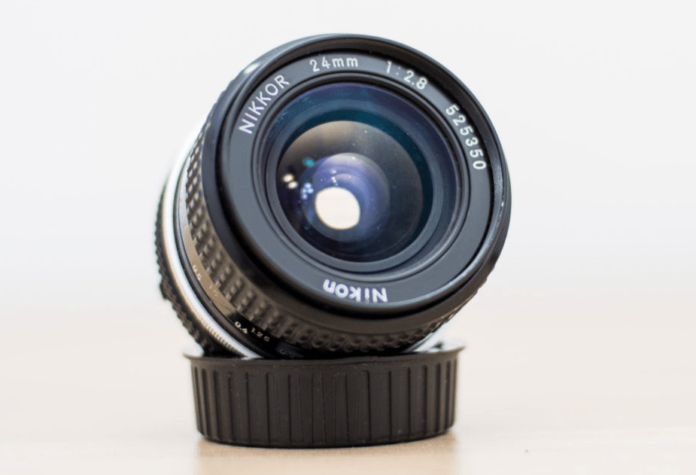Photographers have long favored the Nikon 24 AIS f2 vs f2.8 as two timeless wide-angle prime lenses. Although each lens has unique attributes, it can be difficult to decide between them, particularly when weighing aspects like construction quality, image quality, weight, aperture, and overall value. We will examine both lenses in-depth in this book, contrasting their salient characteristics, operational capabilities, and useful uses to assist you in selecting the one that best meets your requirements.
Table of Contents
Overview of the Nikon 24mm AI-S f/2 and f/2.8
Nikon 24 AIS f2 vs f2.8
Because of its well-known brilliant aperture, the Nikon 24 AIS f2 vs f2.8 lens is a fantastic option for taking pictures in low light and attaining a shallow depth of field. When it was first released in the early 1980s, professional photographers took to it right away because of its superb build quality, sharpness, and contrast.
Nikon 24mm AI-S f/2.8
The Nikon 24 AIS f2 vs f2.8 lens is a more lightweight, more portable, and marginally slower lens than the f/2 model. This lens, which was also released in the 1980s, is known for being a high-quality, dependable, and adaptable wide-angle choice. It provides a harmonious blend of cost, mobility, and sharpness.
Build Quality and Design
Build Quality
The metal body of the Nikon 24 AIS f2 vs f2.8 lenses give them a solid, long-lasting feel. These are from the renowned AI-S (Automatic Indexing Shutter) series from Nikon, which is renowned for its superb construction and manual focus layout. For photographers who want dependable equipment, these lenses are perfect because they can tolerate rough usage. Because of its wider maximum aperture, the f/2 lens is slightly heavier and bulkier than the f/2.8 variant, which is smaller and lighter. Though it might not seem like much, the difference in size and weight can matter when lugging your equipment for long stretches of time, particularly if you’re a street or travel photographer.
Handling and Focus Ring
Focusing is a pleasure because to the smooth, accurate, and user-friendly manual focus ring on both lenses. The f/2.8 lens is easier to handle and less noticeable on your camera body due to its smaller size, while the f/2 lens’s larger barrel makes it more comfortable to grip.
Aperture and Low-Light Performance
Maximum Aperture
The Nikon 24 AIS f2 vs f2.8 maximum aperture and the 24mm f/2.8 lens’s f/2.8 maximum aperture are the two lenses’ most notable differences. The f/2 aperture’s bigger opening lets in more light to the camera sensor, which makes it ideal for low-light and nighttime photography as well as scenarios when you want to achieve a narrower depth of field. Even though it is a little slower, the Nikon 24 AIS f2 vs f2.8 lens is still good in low light and won’t separate the backdrop as much as the f/2. The f/2 variant is obviously better if you regularly take pictures in low light or need a lens that produces a lot of bokeh.
Depth of Field
A shallower depth of field is possible with the f/2 lens, which facilitates isolating your subject from the backdrop. When taking environmental photographs, this is especially helpful because it allows you to highlight the individual against a gentle, blurry background. Even at wider apertures, the f/2.8 lens produces pleasant background blur with less of this effect.
Image Quality
Sharpness
Regarding sharpness, both lenses function quite well. Even when used at wide apertures, the Nikon 24 AIS f2 vs f2.8 is highly recognized for its exceptional crispness throughout the frame. It generates photographs that are crisp, precise, and have good contrast, which makes it an excellent option for street, architecture, and landscape photography. While still quite sharp, the 24mm f/2 lens has a tendency to be a little softer at f/2, particularly in the corners. Reducing the stop size to f/2.8 or f/4 significantly enhances sharpness, approaching that of the f/2.8 lens. In particular, for landscape photography, the f/2.8 may be a preferable option if clarity is your primary concern.
Distortion and Chromatic Aberration
There is very little distortion on either lens, although the f/2.8 lens does a little better. Both lenses have excellent control over chromatic aberration, or color fringing; but, at wider apertures, the f/2 lens may exhibit somewhat greater aberration. You can fix this in post-processing, but if you frequently shoot scenes with a lot of contrast, it’s something to keep in mind.
Vignetting
When shooting with the f/2 lens wide open, vignetting (darkening of the corners) is more noticeable; but, when you stop down to lesser apertures, vignetting becomes much less noticeable. The f/2.8 lens is a better option if your job requires uniform exposure throughout the frame because it generally shows less vignetting.
Bokeh and Rendering
Because of its wider maximum aperture, the f/2 lens produces bokeh (the quality of the out-of-focus areas) that is smoother and more attractive. Because of this, it’s perfect for creative photography and subject isolation if backdrop blur is needed. Although not as dreamy or obvious as the f/2 lens, the bokeh produced by the f/2.8 lens is still rather good.
Portability and Size
The Nikon 24 AIS f2 vs f2.8 is the obvious choice if portability is your top concern. It is more convenient to take around for extended periods of time because it is lighter and more compact. Although the f/2 lens is bigger and bulkier, most photographers may still use it. The f/2.8 lens is a more practical choice if you travel frequently or take pictures while on the run.
Price and Value
The bigger aperture and improved low-light performance of theNikon 24 AIS f2 vs f2.8 usually translate into a higher price tag than the f/2.8 version. Conversely, the f/2.8 lens provides outstanding performance at a more reasonable cost. The f/2.8 variant is a better deal if you’re on a tight budget or don’t require the extra stop of light that the f/2 lens provides.
Which One Should You Choose?
- You require a bigger maximum aperture since you shoot in low light circumstances rather often.
- You want a lens that can create more noticeable bokeh and a shallower depth of field.
- If a somewhat heavier and larger lens gives you more creative alternatives, that’s okay with you.
Choose the Nikon 24mm AI-S f/2.8 If:
An Nikon 24 AIS f2 vs f2.8 aperture is plenty for street scenes, architecture, and landscape photography.
You need a lens that is portable, lightweight, and small.
Conclusion
With their own merits, the Nikon 24 AIS f2 vs f2.8 lenses are both excellent options for wide-angle photography. The f/2.8 lens is well-known for its clarity, mobility, and general value, while the f/2 lens shines in low light and produces artistic bokeh. In the end, your choice will be based on your needs, style, and financial constraints as a photographer. Regardless of the lens you select, you will receive a premium item of glass that offers the legendary Nikon experience.



